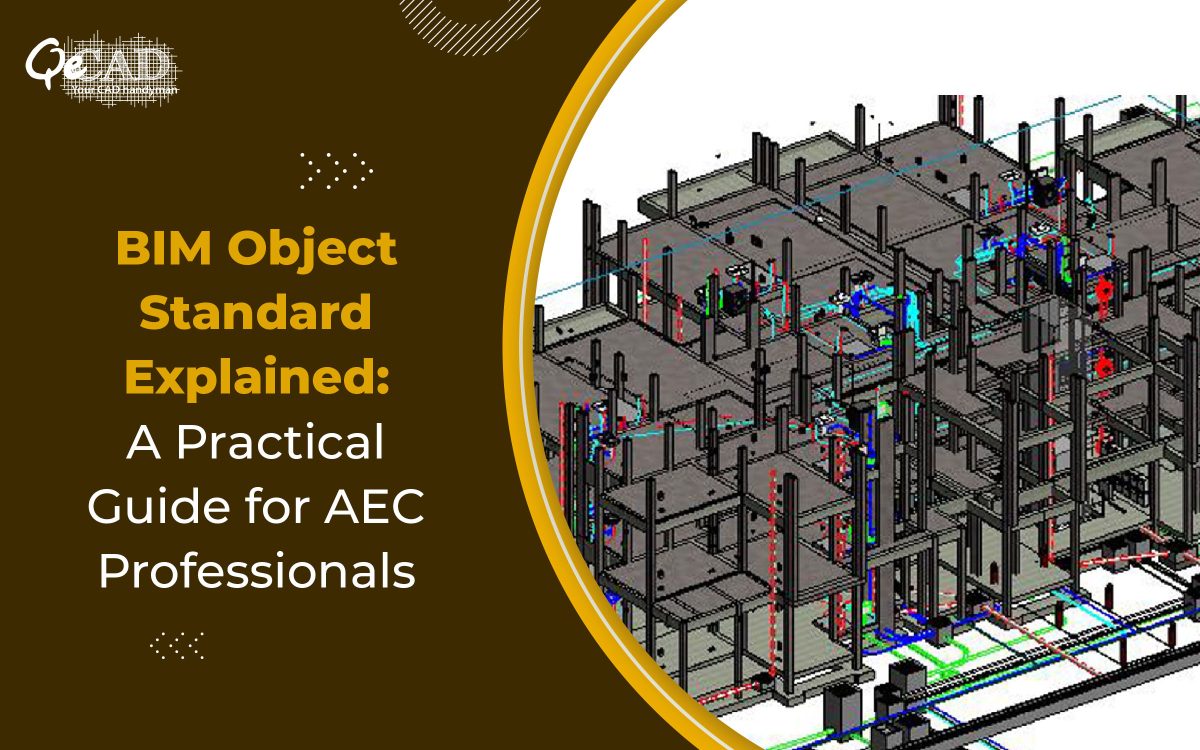
19 Aug 2025
By : dolly / Comments 0
BIM Object Standard Explained: A Practical Guide for AEC Professionals
In today’s rapidly advancing AEC landscape, BIM has become the backbone of the digital project delivery. Central to effective BIM workflows are BIM objects — the digital representations of the real-world products, systems and components.
However, for these objects to be useful across diverse stakeholders and software platforms, they must follow a standardized structure and data format. This is where the BIM Object Standard plays a pivotal role.
In this blog, we will break down what the BIM Object Standard is, why it matters and how AEC professionals can leverage it for efficiency, accuracy and interoperability.
What is the BIM Object Standard?
The BIM Object Standard is a set of guidelines that defines how the BIM objects should be created, structured and shared.
It covers aspects such as:
- Geometry – ensuring objects have the right level of detail (LOD) for different project stages.
- Data – standardized property sets, parameters and classifications for consistency.
- File Formats – compatibility across BIM platforms like Revit, ArchiCAD or IFC-based tools.
- Naming Conventions – a uniform way of labeling elements to avoid any confusion.
Standards such as BS 8541 in the UK or the NBS BIM Object Standard are widely recognized and they often form the baseline for the quality BIM object creation.
Why the BIM Object Standard Matters in AEC?
1. Improves Collaboration
In large, multidisciplinary projects, teams need to share the BIM models seamlessly. A standard ensures that the objects behave predictably, regardless of who created them or which software is used.
2. Enhances Accuracy and Reliability
A standardized BIM object contains verified dimensions, specifications and performance data, reducing the errors during the design, estimations as well as the construction.
3. Saves Time
With standardized libraries, designers and engineers can quickly find and insert the ready-to-use, compliant objects — speeding up the modeling process.
4. Supports Lifecycle Management
Since BIM is not just for design but also for facility management, standardized objects ensures that the data remains accurate and usable throughout the building’s lifecycle.
Key Elements of the BIM Object Standard
- Geometry Requirements
- Appropriate Levels of Detail (LOD) for each project phase (e.g., LOD 100–500).
- Clean, efficient geometry that doesn’t overload the model.
- Data Structure
- Defined parameter naming.
- Compliance with classifications like Uniclass 2015, OmniClass or MasterFormat.
- Inclusion of the manufacturer data where applicable.
- Metadata and Tags
- Functional metadata for searching, filtering and sorting within the BIM libraries.
- File Format & Interoperability
- Deliverables in the native BIM formats (e.g., .rfa, .gsm) and open standards like IFC.
Finding Reliable Sources of BIM Objects
Even with a solid understanding of the BIM Object Standard, the AEC professionals face the challenges of sourcing trustworthy, high-quality objects. The wrong object — poorly modeled, missing data or non-compliant — can lead to the costly project errors.
Here’s how to ensure the quality sourcing:
1. Trusted Repositories like the NBS National Library
Platforms such as the NBS National BIM Library offers the standardized, verified objects that comply with the recognized standards. This makes them a go-to choice for the architects, engineers and a BIM Company looking to maintain the accuracy and consistency.
2. Manufacturer-Specific vs Generic Options
- Manufacturer-Specific Objects – Ideal when the brand accuracy is required, containing the real-world specifications for precise modeling and procurement.
- Generic Objects – Useful during the early design phases when the exact product selection is yet to be made.
3. Reducing Risks by Using Standardized Libraries
Using pre-approved, standardized libraries reduces the risks like incompatible geometry, missing data or incorrect classifications. This approach is especially important for the Revit Family Creation Services, where developing custom components still needs to align well with the industry standards.
Benefits for AEC Professionals
Whether you’re an architect, MEP engineer, contractor or a facility manager, the BIM Object Standard delivers the tangible value:
- For Architects: It ensures that the design intent is accurately represented without any unnecessary file bloat.
- For Engineers: It facilitates the precise performance simulations and coordination.
- For Contractors: It improves the constructability reviews and cost estimation.
- For Facility Managers: It simplifies the asset tracking and maintenance scheduling post-handover.
Challenges in Implementing the BIM Object Standard
While the benefits are clear, its adoption can face hurdles:
- Lack of Awareness – Not all stakeholders can understand the long-term value of the standardization.
- Manufacturer Variability – Inconsistent quality of the manufacturer-provided BIM content.
- Time Investment – Creating compliant objects requires initial effort and training.
Best Practices for AEC Teams
- Use the pre-approved BIM object libraries (e.g., NBS, BIMobject, custom in-house libraries).
- Train teams on the LOD requirements and data standards.
- Adopt a BIM execution plan (BEP) that defines the object requirements from the start.
- Leverage the automation tools for the batch parameter updates and quality checks.
Conclusion
The BIM Object Standard is more than just a technical guideline — it’s a foundation for the consistency, quality and interoperability in the modern construction projects.
For the AEC professionals, embracing the standardized BIM objects ensures the smoother collaboration, better design accuracy and a more efficient project delivery.
As the digital construction advances, those who integrates these standards into their workflows will not only save the time and costs but will also deliver the higher-value projects that stands the test of time.

